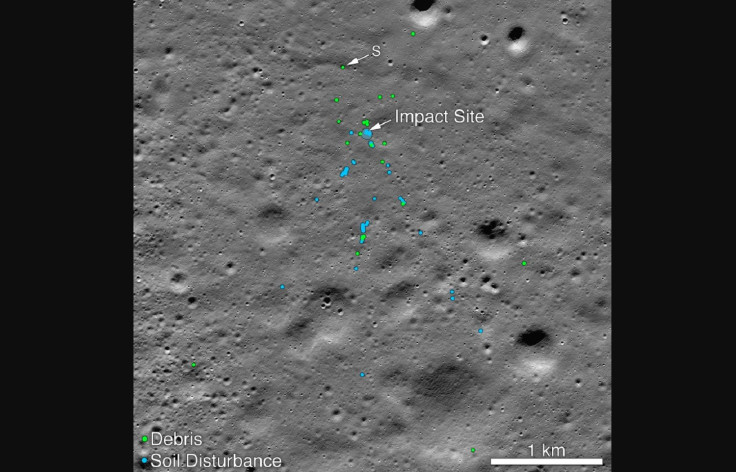NASA Spacecraft Spots Crash Site Of India's Chandrayaan-2 Lunar Lander
The Indian Space Research Organization (ISRO) lost contact with the Chandrayaan-2 Vikram Lander shortly before it was scheduled to touch down on the surface of the moon, 6 kilometers from the South Pole.
Initially, NASA’s Lunar Reconnaissance Orbiter (LRO) passed over the crash site but was not able to identify or image the lander, possibly because it was dusk when LRO passed and shadows were covering much of the terrain.
Later in the month, the LRO team released the first mosaic images of the crash site for the public to help find signs of the lander, and according to the agency, an individual named Shanmuga Subramanian contacted them about a possible crash site.
The identified site with a debris field 466 miles away was then confirmed by NASA by comparing before and after images of the area.
The image of the impact site shows the place where the Vikram lander likely crashed, surrounded by green dots to indicate debris as well as blue dots to indicate the soil disturbance as a result of the crash.
India Moon Mission
If India had succeeded in landing the spacecraft, it would have been one of the few nations to make a soft landing on the moon following the United States, China, and the former Soviet Union. Had it landed on the far side of the moon as planned, the next stages would have been for the rover “Pragyan,” which means “wisdom,” to travel the lunar surface and collect samples for analysis.
Despite the crash, the mission's Orbiter, which was supposed to relay communication between Vikram and the Earth, is now circling the moon and is transmitting data to India. According to ISRO, the Orbiter has the highest resolution camera in any moon mission so far so it will be able to provide high-resolution images that will be very useful to the scientific community.
Even if the lander crashed moment before the landing, getting so close to the surface is already an achievement of its own, especially since it was only India's second moon mission and first lunar landing attempt with a low budget.
Further, the feat still makes for an excellent stepping stone for ISRO's planned 2022 manned mission to the moon.

© Copyright IBTimes 2025. All rights reserved.






















